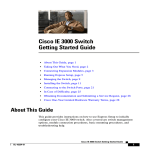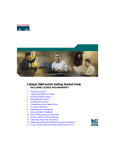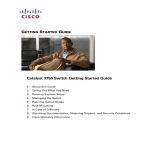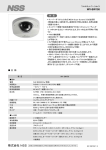Download Cisco Systems 2975 Switch User Manual
Transcript
GETTING STARTED GUIDE Catalyst 2975 Switch Getting Started Guide 1 About this Guide 2 Unpacking the Switch 3 Running Express Setup 4 Managing the Switch 5 Planning Switch Stacks 6 Rack-Mounting 7 In Case of Difficulty 8 Obtaining Documentation and Submitting a Service Request 1 About this Guide This guide provides instructions on how to use Express Setup to initially configure your Catalyst switch. Also covered are switch management options, basic rack-mounting, stacking guidelines, port and module connection procedures, and troubleshooting help. For additional installation and configuration information for the switch, see the Catalyst 2975 documentation on Cisco.com. For system requirements, important notes, limitations, open and resolved bugs, and last-minute documentation updates, see the release notes, also on Cisco.com. For translations of the warnings that appear in this publication, see the Regulatory Compliance and Safety Information for the Catalyst 2975 Switch on the documentation CD. The product warranty information is also included on the documentation CD. When using the online publications, refer to the documents that match the Cisco IOS software version running on the switch. The software version is on the Cisco IOS label on the switch rear panel. 2 Unpacking the Switch Follow these steps: 1. Unpack and remove the switch and the accessory kit from the shipping box. 2. Return the packing material to the shipping container, and save it for future use. 3. Verify that you have received the items shown below. If any item is missing or damaged, contact your Cisco representative or reseller for instructions. 1 ct du on ro ti P nta co e is m D C cu C o D Series PoE-48 3 5 4 6 7 8 9 11 10 205076 Catalyst 2975G 2 1 Catalyst 2975 switch 7 Four rubber mounting feet 2 Documentation 8 Six number-8 Phillips flat-head screws 3 AC power cord 9 Four number-12 Phillips machine screws 4 Console cable 10 One black Phillips machine screw 5 Two 19-inch mounting brackets 11 Connector cover for redundant power system; two number-4 pan head screws 6 Cable guide 2 3 Running Express Setup When you first set up the switch, you should use Express Setup to enter the initial IP information. Doing this enables the switch to connect to local routers and the Internet. You can then access the switch through the IP address for further configuration. You need this equipment to set up the switch: • A PC with Windows 2000 or XP installed • A web browser (Internet Explorer 6.0, 7.0, Firefox 1.5, 2.0, Windows Vista OS) with JavaScript enabled • A straight-through or crossover Category 5 Ethernet cable to connect your PC to the switch Before running Express Setup, disable any pop-up blockers or proxy settings in your browser software and any wireless client running on your PC. During Express Setup, the switch acts as a DHCP server. If your PC has a static IP address, change your PC settings before you begin to temporarily use DHCP. To run Express Setup: Step 1 Make sure that nothing is connected to the switch. Series PoE-48 205077 Catalyst 2975G Step 2 Power the switch by connecting the AC power cord to the switch power supply and to a grounded AC outlet. STACK 1 STACK 2 CONSO LE DC INPUTS FOR REMOTE POWER SUPPLY SPECIF 205078 IED IN MANUAL Step 3 When the switch powers on, it begins the power-on self-test (POST). During POST, the LEDs blink while tests verify that the switch functions properly. Wait for the switch to complete POST, which can take several minutes. Verify that POST has completed by confirming that the SYST LED remains green. If the switch fails POST, the SYST LED turns amber. See the “In Case of Difficulty” section on page 14 if your switch fails POST. Step 5 Press and hold the Mode button for 3 seconds. When all of the LEDs above the Mode button turn green, release the Mode button. Catalyst 2975G Series PoE-48 205079 Step 4 Step 6 If the LEDs above the Mode button blink after you press the button, release it. Blinking LEDs mean that the switch is already configured and cannot go into Express Setup mode. For more information, see the “Resetting the Switch” section on page 15. Step 7 Verify that the switch is in Express Setup mode. Make sure that all LEDs above the Mode button are green. (On some switch models, the RPS LED remains off.) Step 8 Connect a Category 5 Ethernet cable to any Ethernet port on the switch front panel. Catalyst 2975G Series PoE-48 205080 Connect the other end of the cable to the Ethernet port on your PC. 3 Step 9 Verify that the LEDs on both Ethernet ports are green. Wait 30 seconds. Step 10 Launch a web browser on your PC. Enter the IP address 10.0.0.1 in the web browser, and press Enter. Step 11 The Express Setup Basic Settings page appears. If it does not appear, see the “In Case of Difficulty” section on page 14. Step 12 Enter this information in the Network Settings fields: • In the Management Interface (VLAN ID) field, the default is 1. Enter a new VLAN ID only if you want to change the management interface through which you manage the switch and to which you assign IP information. The VLAN ID range is 1 to 1001. • In the IP Address field, enter the IP address of the switch. In the IP Subnet Mask field, click the drop-down arrow, and select an IP Subnet Mask. • In the Default Gateway field, enter the IP address for the default gateway (router). • Enter your password in the Switch Password field. The password can be from 1 to 25 alphanumeric characters, can start with a number, is case sensitive, allows embedded spaces, but does not allow spaces at the beginning or end. In the Confirm Switch Password field, enter your password again. 4 Step 13 (Optional) You can enter the Optional Settings information now or enter it later by using the device manager interface: • In the Host Name field, enter a name for the switch. The host name is limited to 31 characters; embedded spaces are not allowed. • In the System Contact field, enter the name of the person who is responsible for the switch. In the System Location field, enter the wiring closet, floor, or building where the switch is located. • In the Telnet Access field, click Enable if you are going to use Telnet to manage the switch by using the command-line interface (CLI). If you enable Telnet access, you must enter a Telnet password. • In the Telnet Password field, enter a password. The Telnet password can be from 1 to 25 alphanumeric characters, is case sensitive, allows embedded spaces, but does not allow spaces at the beginning or end. In the Confirm Telnet Password field, re-enter the Telnet password. • In the SNMP field, click Enable to enable Simple Network Management Protocol (SNMP). Enable SNMP only if you plan to manage switches by using CiscoWorks 2000 or another SNMP-based network-management system. If you enable SNMP, you must enter a community string in the SNMP Read Community field, the SNMP Write Community field, or both. SNMP community strings authenticate access to MIB objects. Embedded spaces are not allowed in SNMP community strings. When you set the SNMP read community, you can access SNMP information, but you cannot modify it. When you set the SNMP write community, you can both access and modify SNMP information. Step 14 Click Submit to save your settings, or click Cancel to clear your settings. When you click Submit, the switch is configured and exits Express Setup mode. The PC displays a warning message and then tries to connect with the new switch IP address. If you configured the switch with an IP address that is in a different subnet from the PC, connectivity between the PC and the switch is lost. Step 15 Disconnect the switch from the PC, and install the switch in your network. See the “Managing the Switch” section on page 6 for information about configuring and managing the switch. If you need to rerun Express Setup, see the “Resetting the Switch” section on page 15. Refreshing the PC IP Address After you complete Express Setup, you should refresh the PC IP address: • For a dynamically assigned IP address, disconnect the PC from the switch, and reconnect the PC to the network. The network DHCP server assigns a new IP address to the PC. • For a statically assigned IP address, change it to the previously configured IP address. 5 4 Managing the Switch After you complete Express Setup and install the switch in your network, use the device manager or other management options described in this section for further configuration. Using the Device Manager The simplest way to manage the switch is by using the device manager in the switch memory. This web interface offers quick configuration and monitoring. You can access the device manager from anywhere in your network through a web browser. Follow these steps: 1. Launch a web browser on your PC or workstation. 2. Enter the switch IP address in the web browser, and press Enter. The device manager page appears. 3. Use the device manager to perform basic switch configuration and monitoring. Refer to the device manager online help for more information. 4. For more advanced configuration, download and run the Cisco Network Assistant, which is described in the next section. Downloading Cisco Network Assistant Cisco Network Assistant is a software program that you download from Cisco.com and run on your PC. It offers advanced options for configuring and monitoring multiple devices, including switches, switch clusters, switch stacks, routers, and access points. Network Assistant is free—there is no charge to download, install, or use it. Follow these steps: 1. Go to this Web address: http://www.cisco.com/go/NetworkAssistant. You must be a registered Cisco.com user, but you need no other access privileges. 2. Find the Network Assistant installer. 3. Download the Network Assistant installer, and run it. (You can run it directly from the Web if your browser offers this choice.) 4. When you run the installer, follow the displayed instructions. In the final panel, click Finish to complete the Network Assistant installation. Refer to the Network Assistant online help and the getting started guide for more information. Command-Line Interface You can enter Cisco IOS commands and parameters through the CLI. Access the CLI either by connecting your PC directly to the switch console port or through a Telnet session from a remote PC or workstation. Follow these steps: 1. Connect the supplied RJ-45-to DB-9 adapter cable to the standard 9-pin serial port on the PC. Connect the other end of the cable to the console port on the switch. 2. Start a terminal-emulation program on the PC. 3. Configure the PC terminal emulation software for 9600 baud, 8 data bits, no parity, 1 stop bit, and no flow control. 4. Use the CLI to enter commands to configure the switch. See the software configuration guide and the command reference for more information. 6 Other Management Options You can use SNMP management applications such as CiscoWorks Small Network Management Solution (SNMS) and HP OpenView to configure and manage the switch. You also can manage it from an SNMP-compatible workstation that is running platforms such as HP OpenView or SunNet Manager. The Cisco IE2100 Series Configuration Registrar is a network management device that works with embedded Cisco Networking Services (CNS) agents in the switch software. You can use IE2100 to automate initial configurations and configuration updates on the switch. See the “Accessing Help Online” section on page 15 for a list of supporting documentation. 5 Planning Switch Stacks Before connecting the switches in a stack, keep in mind these switch stack guidelines: • Connect only Catalyst 2975 switches in a switch stack. The Catalyst 2975 switch does not support mixed stack configurations. You cannot stack Catalyst 2975 switches with Catalyst 3750 switches or Catalyst 3750-E switches. • Length of cable. Depending on your configurations, you might need different sized cables. If you do not specify the length of the stack cable, the 0.5-meter cable is supplied. If you need the 1-meter cable or the 3-meter cable, you can order it from your Cisco supplier. • Access to the switch rear panel and to the rear of the rack. If you do not have access to the rear panel, make sure that you cable the switches before you rack-mount them. For switch dimensions, stack cable part numbers, and additional stacking guidelines, see the switch hardware installation guide on Cisco.com. For concepts and procedures to manage switch stacks, see the switch software configuration guide and the stack compatibility guide also on Cisco.com. Powering Guidelines Consider the following guidelines before you power the switches in a stack: • The sequence in which the switches are initially powered on might affect the switch that becomes the stack master. • If you want a particular switch to become the stack master, power on that switch first. This switch becomes the stack master and remains the stack master until a master re-election is required. After 20 seconds, power on the remaining switches in the stack. • If you have no preference for which switch becomes the stack master, power on all the switches in the stack within a 20-second timeframe. These switches participate in the stack master election. Switches powered on after the 20-second timeframe do not participate in the election. • Power off a switch before you add it to or remove it from an existing switch stack. For more information on stack master elections, see the “Managing Switch Stacks” chapter in the switch software configuration guide on Cisco.com. 7 Cabling Guidelines These illustrations show the recommended switch stack configurations with redundant stack cabling connections for optimized stack bandwidth. For more configuration examples, see the hardware installation guide on Cisco.com. 250579 In this example, the stack uses the 0.5-meter stack cable to make redundant connections. 250580 In this example, the stacks use both 0.5- and 3-meter stack cables to make redundant connections. 8 6 Rack-Mounting This section covers basic 19-inch rack-mounting and switch port connections. For alternate mounting procedures, such as installing the switch in a 24-inch rack or on a wall, and for additional cabling information, see the hardware installation guide on Cisco.com. Equipment That You Supply You need a number-2 Phillips screwdriver to rack-mount the switch. Before You Begin Before installing the switch, verify that these guidelines are met: • Clearance to front and rear panels is such that – Front-panel indicators can be easily read. – Access to ports is sufficient for unrestricted cabling. • Confirm that you have access to the switch rear panel to connect the optional RPS 2300 or the RPS 675. If you do not have access to the rear panel, you should cable the switches before you rack-mount them. • Verify that the AC power cord can reach from the AC power outlet to the connector on the switch rear panel. • Cabling is away from sources of electrical noise, such as radios, power lines, and fluorescent lighting fixtures. Make sure the cabling is safely away from other devices that might damage the cables. • Airflow around the switch and through the vents is unrestricted. • Temperature around the unit does not exceed 113°F (45°C). If the switch is installed in a closed or multirack assembly, the temperature around it might be greater than normal room temperature. • Humidity around the switch does not exceed 85 percent. • Altitude at the installation site is not greater than 10,000 feet. • For copper connections on Ethernet ports, cable lengths from the switch to connected devices can be up to 328 feet (100 meters). • For cable lengths for SFP-module connections, see the hardware installation guide on Cisco.com and the documentation that shipped with the module. 9 Installation Warning Statements This section includes the basic installation warning statements. Translations of these warning statements appear in the Regulatory Compliance and Safety Information for the Catalyst 2975 Switch document on the documentation CD. Warning To prevent bodily injury when mounting or servicing this unit in a rack, you must take special precautions to ensure that the system remains stable. The following guidelines are provided to ensure your safety: This unit should be mounted at the bottom of the rack if it is the only unit in the rack. When mounting this unit in a partially filled rack, load the rack from the bottom to the top with the heaviest component at the bottom of the rack. If the rack is provided with stabilizing devices, install the stabilizers before mounting or servicing the unit in the rack. Statement 1006 Warning Only trained and qualified personnel should be allowed to install, replace, or service this equipment. Statement 1030 Before Attaching the Brackets Catalyst 29 75G Series PoE-48 10 205084 To install the switch in a rack, you must first remove the screws from the switch chassis so that the mounting brackets can be attached. For attachment at the front-mounting position remove one Phillips truss-head screw from the switch side panels. For attachment at the mid-mounting position, remove two screws. For attachment at the rear-mounting position, remove one screw. Attaching the Brackets Use two number-8 Phillips flat-head screws to attach the long side of each bracket to the switch in one of three mounting positions. 1 2 Catalyst 2975 G Series PoE -48 2 3 2 Catalyst 2975 G Series PoE -48 2 4 STACK 1 STACK 2 CONSOLE DC INP UTS FOR REMOTE POW SPECIFI ER SUPPLY ED IN MANUAL 205081 2 2 1 Front-mounting position 3 Mid-mounting position 2 Number-8 Phillips flat-head screws 4 Rear-mounting position 11 Rack-Mount the Switch Use the four number-12 Phillips machine screws to attach the brackets to the rack. Use the black Phillips machine screw to attach the cable guide to the left or right bracket. 3 1 2 Catalyst 2975 5 G Series PoE48 4 Catalyst 2975 G Series PoE48 4 6 STACK 1 STACK 2 CONSOL E 205082 DC INPU TS FOR REMOTE POW SPECIFI ER SUPPLY ED IN MANUAL 1 Black Phillips machine screw 4 Number-12 Phillips machine screws 2 Cable guide 5 Mid-mounting position 3 Front-mounting position 6 Rear-mounting position 12 Connect the Stack Cables Use the window in the stack cable to align the connector correctly. Insert the cable into the stack port on the back of the switch. Secure the screws tightly. Insert the other end of the cable into the connector of the other switch, and secure the screws tightly. Always use a Cisco-approved stack cable to connect the switches. Connect only Catalyst 2975 switches in a switch stack. The Catalyst 2975 switch does not support mixed stack configurations. You cannot stack Catalyst 2975 switches with Catalyst 3750 switches or Catalyst 3750-E switches. STACK Caution 1 STACK 2 CONSOL E Removing and installing the stack cable can shorten its useful life. Do not remove and insert the cable more often than is absolutely necessary. Connect to the Switch Ports This section describes how to connect to the fixed switch ports and to the SFP module slots. Connect to 10/100/1000 PoE Ports The 10/100/1000 PoE ports use standard RJ-45 connectors with Ethernet pinouts. The maximum cable length is 328 feet (100 meters). The 100BASE-TX and 1000BASE-T traffic requires Category 5, Category 5e, or Category 6 UTP cable. The 10BASE-T traffic can use Category 3 or Category 4 cable. The ports provide PoE support for devices compliant with IEEE 802.3af and also provide Cisco pre-standard PoE support for Cisco IP Phones and Cisco Aironet Access Points. Each port can deliver 15.4 W of PoE on any 24 of the 48 ports or any combination of the ports can deliver an average of 7.7 W of PoE at the same time, up to a maximum switch power output of 370 W. By default, a switch PoE port automatically provides power when a valid powered device is connected to it. The autonegotiation feature is enabled by default on the switch. At this setting, the switch ports configure themselves to operate at the speed of attached devices. If the attached device does not support autonegotiation, you can explicitly set the switch port speed and the duplex parameters. To maximize performance, either let the ports autonegotiate both speed and duplex, or set the port speed and duplex parameters on both ends of the connection. For simplified cabling, the automatic medium-dependent interface crossover (auto-MDIX) feature is enabled by default on the switch. With auto-MDIX enabled, the switch detects the required cable type for copper Ethernet connections and configures the interface accordingly. Therefore, you can use either a crossover or a straight-through cable for connections to a switch 10/100/1000 PoE port, regardless of the type of device on the other end of the connection. For information about configuring and monitoring PoE ports, enabling or disabling autonegotiation and auto-MDIX, see the switch software configuration guide on Cisco.com. 13 Install SFP Modules and Connect to the Module Ports The switch Gigabit Ethernet SFP modules are used for connections to other devices. These modules are field-replaceable, providing the uplink interfaces when inserted in an SFP module slot. You can use any combination of SFP modules. See the switch release notes for the list of SFP modules that the switch supports. To install an SFP module, position the module in front of the module slot. Insert the SFP module into the slot until you feel the connector on the module snap into place. 5G Series PoE-48 205083 Catalyst 297 After installing the SFP module, use fiber-optic cables with LC or MT-RJ connectors to connect to a fiber-optic SFP module. Use a Category 5 or higher cable with RJ-45 connectors to connect to a copper SFP module. For detailed instructions on installing, removing, and cabling the SFP module, see your SFP module documentation. Use only Cisco SFP modules with the switch. Each SFP module has an internal serial EEPROM that is encoded with security information. This encoding provides a way for Cisco to identify and validate that the SFP module meets the requirements for the switch. Verify Port Connectivity After you connect a device to the switch port, the port LED turns amber while the switch establishes a link. This process takes about 30 seconds. Then the LED turns green when the switch and the attached device have an established link. If the LED is off, the device might not be turned on, there might be a cable problem, or there might be a problem with the adapter installed in the device. See the “In Case of Difficulty” section on page 14 for information about online assistance. 7 In Case of Difficulty If you experience difficulty, help is available in this section and also on Cisco.com. This section includes Express Setup troubleshooting, how to reset the switch, how to access help online, and where to find more information. Troubleshooting Express Setup If Express Setup does not run, or if the Express Setup page does not appear in your browser: Did you verify that POST ran successfully before starting Express Setup? If not, make sure that only the SYST and STAT LEDs are green before you press the Mode button to enter the Express Setup mode. POST errors are usually fatal. Contact your Cisco technical support representative if your switch fails POST. Did you press the Mode button while the switch was still running POST? If yes, wait until POST completes. Power cycle the switch. Wait until POST completes. Confirm that the SYST and STAT LEDs are green. Press the Mode button to enter Express Setup mode. Did you try to continue without confirming that the switch was in Express Setup mode? Verify that all LEDs above the Mode button are green. (The RPS LED is off.) If necessary, press the Mode button to enter Express Setup mode. 14 Does your PC have a static IP address? If yes, before connecting to the switch, change your PC settings to temporarily use DHCP. Did you connect a crossover cable instead of a If yes, connect a straight-through cable to an Ethernet port on straight-through Ethernet cable between a switch port and the the switch and the PC. Wait 30 seconds before you enter Ethernet port of the PC? 10.0.0.1 in the browser. Did you connect the Ethernet cable to the console port instead If yes, disconnect the cable from the console port. Then of to a 10/100/1000 PoE port on the switch? connect the cable to an Ethernet port on the switch and the PC. Wait 30 seconds before you enter 10.0.0.1 in the browser. Did you wait 30 seconds after you connected the switch and the PC before you entered the IP address in your browser? If not, wait 30 seconds, re-enter 10.0.0.1 in the browser, and press Enter. Did you enter the wrong address in the browser, or is there an If yes, re-enter 10.0.0.1 in the browser, and press Enter. error message? Resetting the Switch This section describes how to reset the switch by rerunning Express Setup. These are reasons why you might want to reset the switch: • You installed the switch in your network and cannot connect to it because you assigned an incorrect IP address. • You want to clear all configuration from the switch and assign a new IP address. • You are trying to enter Express Setup mode, and the switch LEDs start blinking when you press the Mode button (which means that the switch is already configured with IP information). Caution Resetting the switch deletes the configuration and reboots the switch. To reset the switch: Press and hold the Mode button. The switch LEDs begin blinking after about 3 seconds. Continue holding down the Mode button. The LEDs stop blinking after 7 more seconds, and then the switch reboots. The switch now behaves like an unconfigured switch. You can enter the switch IP information by using Express Setup as described in the “Running Express Setup” section on page 3. Accessing Help Online You can first look for a solution to your problem in the troubleshooting section of the hardware installation guide or the software configuration guide on Cisco.com. You can also access the Cisco Technical Support and Documentation website for a list of known hardware problems and extensive troubleshooting documentation. 15 Accessing Documentation Online For more information about the switch, see these documents on Cisco.com: http://cisco.com/en/US/products/ps10081/tsd_products_support_series_home.html • Catalyst 2975 Switch Hardware Installation Guide • Regulatory Compliance and Safety Information for the Catalyst 2975 Switch • Release Notes for the Catalyst 2975 Switch • Catalyst 2975 Switch Software Configuration Guide • Catalyst 2975 Switch Command Reference • Catalyst 3750, 3560, 3550, 2975, 2970, and 2960 Switch System Message Guide 8 Obtaining Documentation and Submitting a Service Request For information on obtaining documentation, submitting a service request, and gathering additional information, see the monthly What’s New in Cisco Product Documentation, which also lists all new and revised Cisco technical documentation, at: http://www.cisco.com/en/US/docs/general/whatsnew/whatsnew.html Subscribe to the What’s New in Cisco Product Documentation as a Really Simple Syndication (RSS) feed and set content to be delivered directly to your desktop using a reader application. The RSS feeds are a free service and Cisco currently supports RSS Version 2.0. CCDE, CCENT, Cisco Eos, Cisco Lumin, Cisco Nexus, Cisco StadiumVision, Cisco TelePresence, Cisco WebEx, the Cisco logo, DCE, and Welcome to the Human Network are trademarks; Changing the Way We Work, Live, Play, and Learn and Cisco Store are service marks; and Access Registrar, Aironet, AsyncOS, Bringing the Meeting To You, Catalyst, CCDA, CCDP, CCIE, CCIP, CCNA, CCNP, CCSP, CCVP, Cisco, the Cisco Certified Internetwork Expert logo, Cisco IOS, Cisco Press, Cisco Systems, Cisco Systems Capital, the Cisco Systems logo, Cisco Unity, Collaboration Without Limitation, EtherFast, EtherSwitch, Event Center, Fast Step, Follow Me Browsing, FormShare, GigaDrive, HomeLink, Internet Quotient, IOS, iPhone, iQuick Study, IronPort, the IronPort logo, LightStream, Linksys, MediaTone, MeetingPlace, MeetingPlace Chime Sound, MGX, Networkers, Networking Academy, Network Registrar, PCNow, PIX, PowerPanels, ProConnect, ScriptShare, SenderBase, SMARTnet, Spectrum Expert, StackWise, The Fastest Way to Increase Your Internet Quotient, TransPath, WebEx, and the WebEx logo are registered trademarks of Cisco Systems, Inc. and/or its affiliates in the United States and certain other countries. All other trademarks mentioned in this document or website are the property of their respective owners. The use of the word partner does not imply a partnership relationship between Cisco and any other company. (0809R) © 2008 Cisco Systems, Inc. All rights reserved. Americas Headquarters Asia Pacific Headquarters Europe Headquarters Cisco Systems, Inc. San Jose, CA Cisco Systems (USA) Pte. Ltd. Singapore Cisco Systems International BV Amsterdam, The Netherlands Cisco has more than 200 offices worldwide. Addresses, phone numbers, and fax numbers are listed on the Cisco Website at www.cisco.com/go/offices. OL-17782-01


























